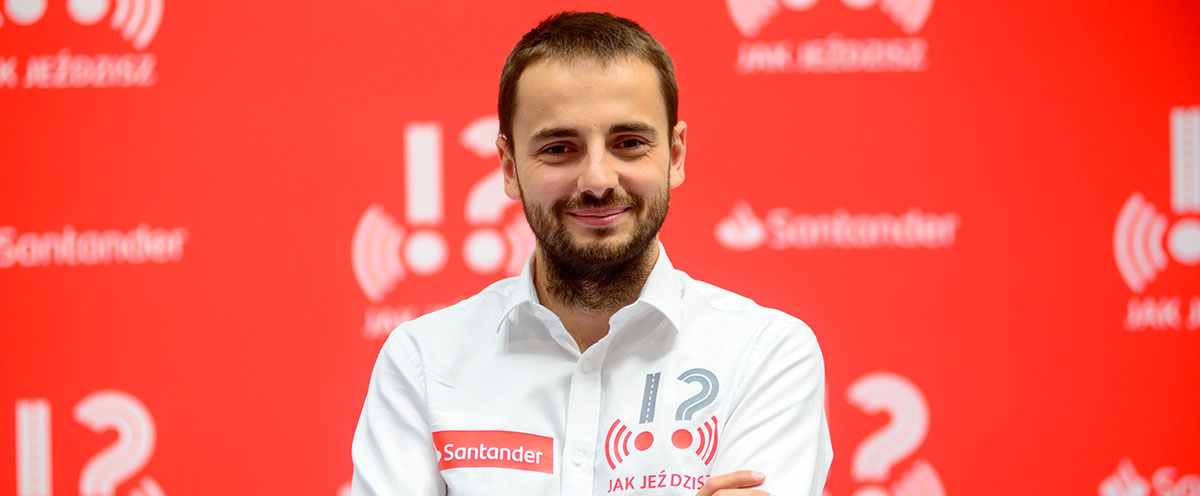- Santander Bank PolskaSantander Bank Polska
- Responsible bankingBank As You Want It
- SimpleBank As You Want It
- FairBank As You Want It
- PersonalBank As You Want It
- About the reportAbout report
Safety
12% of drivers often, or very often, read text messages while driving a car . 7% of respondents text back while driving, 12% of drivers often talk on the phone without using hands-fee sets and 6% of Poles browse through social media behind the wheel, according to the results of a survey of Polish car drivers* carried out at the request of Santander Bank Polska between 27 February and 7 march, 2018.
*Survey of Polish drivers conducted by 4P research mix for Santander Bank Polska in a population of active drivers aged 18 to 70 years (excluding professional drivers). The CAWI survey was carried out using the national quota method on a sample population (N=613)).
How’s your driving?
”Safety happens now”. In accordance with this claim, since 2015 Santander Bank Polska has been running its campaign called ”How’s your driving?” which promotes responsible and polite behavior on the road. The project is based mainly on communication in social media, but includes also meetings organized for local communities. On the ”How’s your driving?” fanpage observed by more than 120,000 persons, with the involvement of Kuba Giermaziak, a racing driver and ambassador of the project, Internet users receive interesting and competent advice on using a car and driving safely and current road traffic information. The provided advice covers a broad range of topics, such as the road etiquette, car operation and equipment, traffic rules, first aid in the case of a road accident, rules of transporting young children and driving technique.

The project is implemented in collaboration with the Partnership for Road Safety – a coalition of the private and public sector and non-governmental organizations the aim of which is to reduce the frequency of road accidents in Poland.
More information can be found on:
#ParkYourPhone&Drive
The results of our road safety survey have inspired us to organize the #ParkYourPhone&Drive campaign. Special advertising spots were produced and broadcast in 124 radio stations to provoke a reflection and discussion. The communicated messages were emotional but the intention was not to scare anyone, but rather give food for thought, warn and make each of us put the phone away and focus only on the road while driving. The #ParkYourPhone&Drive was the biggest social campaign launched by the bank under the How’s Your Driving project.
Ecosafe
The Ecosafe competition was an initiative organized as part of the How’s Your Driving project, together with the Partnership for Road Safety. It was addressed to primary school students with the intention to disseminate the knowledge of road safety rules and environmental principle among the youngest traffic participants. A national art and film competiton was launched for schoolchildren in which they presented their vision of a safe road to school.
“How’s Your Driving” – educational activities and their effects in 2018
An educational event under How’s Your Driving project as an award in the national Ecosafe competition for Primary School no. 1 in Solec Kujawski
-
 514
514students
participating in the event
-
 120
120students
students engaged in preparing 40 works submitted to the competition
-
 350
350persons
A stand during the CSR Exhibition at the National Stadium in Warsaw
-
 500
500persons
An educational stadium during a family event on the Children’s Day in Kamionki near Poznań
-
 700
700persons
Educational stands at family picnics in Gdańsk and Zbrosławice near Katowic (June 2018) and in Poznań and Wrocław (September 2018)
-
 350
350persons
Educational stands at the Polish-Spanish family picnic organized by the Business Chamber on 17 June 2018 in Warsaw
Total number of beneficiaries: 13,373
Safe To Know
”Safe To Know” is a joint, prevention campaign of the police, the Santander Foundation and our volunteers targeting primary school children from the region of Wielkopolska. In 2018, children from 40 schools located in 12 counties were invited to attend meetings. As a result, the information about safe attitudes and behaviours at home, on the street and in contacts with strangers was communicated to approximately 900 schoolchildren.


